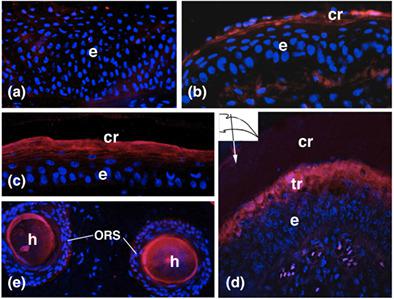当前位置:
X-MOL 学术
›
J. Morphol.
›
论文详情
Our official English website, www.x-mol.net, welcomes your
feedback! (Note: you will need to create a separate account there.)
Immunolabeling indicates that sulfhydryl oxidase is absent in anamniote epidermis but marks the process of cornification in the skin of terrestrial vertebrates
Journal of Morphology ( IF 1.5 ) Pub Date : 2020-11-16 , DOI: 10.1002/jmor.21299 Lorenzo Alibardi 1
Journal of Morphology ( IF 1.5 ) Pub Date : 2020-11-16 , DOI: 10.1002/jmor.21299 Lorenzo Alibardi 1
Affiliation

|
The passage between keratinization to cornification of the epidermis and skin appendages in vertebrates requires formation of a stratum corneum rich in SS bonds among other cross‐linking chemical bonds. A key enzyme, sulfhydryl oxidase (SOXase) catalyzes the oxidation of SH groups present in keratins and in corneous proteins of the epidermis into SS. Presence and distribution of SAXase has been studied by immunohistochemistry in all vertebrates, from fish to mammals. SOXase is immunohistochemically absent in all fish and amphibian species tested with the exception of a thin pre‐corneous layer in the epidermis of adult anurans. SOXase is low to absent in corneous appendages such as horny teeth of lamprey or claws and horny beaks of amphibians. Conversely, SOXase is detected in the transitional (pre‐corneous) and inner corneous layers of the epidermis of sauropsids and mammals. In lepidosaurian reptiles, SOXase appears in both beta‐ and alpha‐corneous‐layers, but is limited to the pre‐corneous and corneous layers of the thin soft epidermises of birds and mammals, including the granular layer. SOXase is localized in pre‐corneous layers and disappears in external corneous layers of amniote skin appendages such as claws, beaks of turtles and birds, and in developing feathers. This distribution further indicates that the increase activity of epidermal SOXase is/was essential, in addition to other enzymes such as epidermal transglutaminases, for the evolution of the corneous layer and of the different hard skin appendages present in terrestrial vertebrates.
中文翻译:

免疫标记表明,羊膜动物表皮中不存在巯基氧化酶,但标志着陆生脊椎动物皮肤的角质化过程
脊椎动物的表皮和皮肤附属器的角化到角化之间的通道需要形成富含 SS 键和其他交联化学键的角质层。一种关键酶,巯基氧化酶 (SOXase) 催化存在于角蛋白和表皮角质蛋白中的 SH 基团氧化为 SS。SAXase 的存在和分布已通过免疫组织化学在从鱼类到哺乳动物的所有脊椎动物中进行了研究。除了成年无尾蜥的表皮中有一层薄薄的前角质层外,所有测试的鱼类和两栖动物物种中都不存在 SOXase。SOXase 在角质附属物(如七鳃鳗的角质牙齿或两栖动物的爪和角质喙)中含量低至不存在。反过来,在蜥脚类和哺乳动物的表皮的过渡层(前角质层)和内部角质层中检测到 SOXase。在鳞龙类爬行动物中,SOXase 出现在 β 和 α 角质层中,但仅限于鸟类和哺乳动物薄软表皮的前角质层和角质层,包括颗粒层。SOXase 位于前角质层中,在羊膜皮肤附属物的外部角质层中消失,例如爪子、乌龟和鸟类的喙,以及发育中的羽毛。这种分布进一步表明,除了其他酶如表皮转谷氨酰胺酶外,表皮 SOXase 的活性增加对于角质层和陆生脊椎动物中存在的不同硬皮附属物的进化是必不可少的。在鳞龙类爬行动物中,SOXase 出现在 β 和 α 角质层中,但仅限于鸟类和哺乳动物薄软表皮的前角质层和角质层,包括颗粒层。SOXase 位于前角质层中,在羊膜皮肤附属物的外部角质层中消失,例如爪子、乌龟和鸟类的喙,以及发育中的羽毛。这种分布进一步表明,除了其他酶如表皮转谷氨酰胺酶外,表皮 SOXase 的活性增加对于角质层和陆生脊椎动物中存在的不同硬皮附属物的进化是必不可少的。在鳞龙类爬行动物中,SOXase 出现在 β 和 α 角质层中,但仅限于鸟类和哺乳动物薄软表皮的前角质层和角质层,包括颗粒层。SOXase 位于前角质层中,在羊膜皮肤附属物的外部角质层中消失,例如爪子、乌龟和鸟类的喙,以及发育中的羽毛。这种分布进一步表明,除了其他酶如表皮转谷氨酰胺酶外,表皮 SOXase 的活性增加对于角质层和陆生脊椎动物中存在的不同硬皮附属物的进化是必不可少的。但仅限于鸟类和哺乳动物薄而柔软的表皮的前角质层和角质层,包括颗粒层。SOXase 定位于前角质层,消失在羊膜皮肤附属物的外部角质层,如爪子、乌龟和鸟类的喙,以及发育中的羽毛。这种分布进一步表明,除了其他酶如表皮转谷氨酰胺酶外,表皮 SOXase 的活性增加对于角质层和陆生脊椎动物中存在的不同硬皮附属物的进化是必不可少的。但仅限于鸟类和哺乳动物薄而柔软的表皮的前角质层和角质层,包括颗粒层。SOXase 位于前角质层中,在羊膜皮肤附属物的外部角质层中消失,例如爪子、乌龟和鸟类的喙,以及发育中的羽毛。这种分布进一步表明,除了其他酶如表皮转谷氨酰胺酶外,表皮 SOXase 的活性增加对于角质层和陆生脊椎动物中存在的不同硬皮附属物的进化是必不可少的。
更新日期:2020-11-16
中文翻译:

免疫标记表明,羊膜动物表皮中不存在巯基氧化酶,但标志着陆生脊椎动物皮肤的角质化过程
脊椎动物的表皮和皮肤附属器的角化到角化之间的通道需要形成富含 SS 键和其他交联化学键的角质层。一种关键酶,巯基氧化酶 (SOXase) 催化存在于角蛋白和表皮角质蛋白中的 SH 基团氧化为 SS。SAXase 的存在和分布已通过免疫组织化学在从鱼类到哺乳动物的所有脊椎动物中进行了研究。除了成年无尾蜥的表皮中有一层薄薄的前角质层外,所有测试的鱼类和两栖动物物种中都不存在 SOXase。SOXase 在角质附属物(如七鳃鳗的角质牙齿或两栖动物的爪和角质喙)中含量低至不存在。反过来,在蜥脚类和哺乳动物的表皮的过渡层(前角质层)和内部角质层中检测到 SOXase。在鳞龙类爬行动物中,SOXase 出现在 β 和 α 角质层中,但仅限于鸟类和哺乳动物薄软表皮的前角质层和角质层,包括颗粒层。SOXase 位于前角质层中,在羊膜皮肤附属物的外部角质层中消失,例如爪子、乌龟和鸟类的喙,以及发育中的羽毛。这种分布进一步表明,除了其他酶如表皮转谷氨酰胺酶外,表皮 SOXase 的活性增加对于角质层和陆生脊椎动物中存在的不同硬皮附属物的进化是必不可少的。在鳞龙类爬行动物中,SOXase 出现在 β 和 α 角质层中,但仅限于鸟类和哺乳动物薄软表皮的前角质层和角质层,包括颗粒层。SOXase 位于前角质层中,在羊膜皮肤附属物的外部角质层中消失,例如爪子、乌龟和鸟类的喙,以及发育中的羽毛。这种分布进一步表明,除了其他酶如表皮转谷氨酰胺酶外,表皮 SOXase 的活性增加对于角质层和陆生脊椎动物中存在的不同硬皮附属物的进化是必不可少的。在鳞龙类爬行动物中,SOXase 出现在 β 和 α 角质层中,但仅限于鸟类和哺乳动物薄软表皮的前角质层和角质层,包括颗粒层。SOXase 位于前角质层中,在羊膜皮肤附属物的外部角质层中消失,例如爪子、乌龟和鸟类的喙,以及发育中的羽毛。这种分布进一步表明,除了其他酶如表皮转谷氨酰胺酶外,表皮 SOXase 的活性增加对于角质层和陆生脊椎动物中存在的不同硬皮附属物的进化是必不可少的。但仅限于鸟类和哺乳动物薄而柔软的表皮的前角质层和角质层,包括颗粒层。SOXase 定位于前角质层,消失在羊膜皮肤附属物的外部角质层,如爪子、乌龟和鸟类的喙,以及发育中的羽毛。这种分布进一步表明,除了其他酶如表皮转谷氨酰胺酶外,表皮 SOXase 的活性增加对于角质层和陆生脊椎动物中存在的不同硬皮附属物的进化是必不可少的。但仅限于鸟类和哺乳动物薄而柔软的表皮的前角质层和角质层,包括颗粒层。SOXase 位于前角质层中,在羊膜皮肤附属物的外部角质层中消失,例如爪子、乌龟和鸟类的喙,以及发育中的羽毛。这种分布进一步表明,除了其他酶如表皮转谷氨酰胺酶外,表皮 SOXase 的活性增加对于角质层和陆生脊椎动物中存在的不同硬皮附属物的进化是必不可少的。











































 京公网安备 11010802027423号
京公网安备 11010802027423号